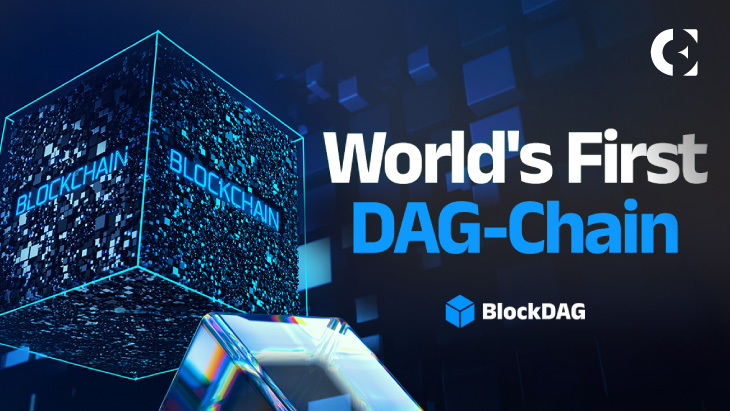The landscape of crypto investments is changing and adapting to the advancements that can be seen from the financial sector to AI integrations. Investors are going to back projects that are able to adapt to changes quickly and scale as new crypto traders join the ecosystem.
Solana may fall behind and BlockDAG (BDAG) charges ahead, simply because it has faced challenges on this very topic. Users have seen outages with Solana and are skeptical about how decentralized the project actually is. BlockDAG has ensured its ability to adapt and scale quickly and has built its entire identity around it.
Solana Quickly Gained Recognition
The Solana blockchain, launched in 2020, has quickly gained recognition for its fast transaction speeds and low fees, making it an appealing choice for developers and users seeking high-frequency, cost-effective transactions. Solana achieves these advantages by combining Proof of History (PoH) with Proof of Stake (PoS), enabling rapid processing that is ideal for applications like NFTs and gaming.
However, Solana’s impressive speed comes with certain trade-offs, including occasional network outages and challenges with decentralization. These factors have raised concerns over stability and network resilience.
BlockDAG Changes The Industry Norm
BlockDAG’s has risen quickly in the crypto market, this rise is largely driven by its use of Directed Acyclic Graph (DAG) technology combined with Proof of Work (PoW), a blend designed to ensure both scalability and security.
Unlike traditional blockchains that process transactions sequentially, BlockDAG’s DAG structure allows multiple transactions to be processed simultaneously. This unique setup enables higher transaction throughput, addressing a key scalability issue faced by many existing blockchains. PoW, meanwhile, provides security by requiring computational effort to validate transactions, safeguarding the network against attacks while maintaining efficiency.
The project’s presale success reflects strong market interest, having raised over $115 million, with 15 billion coins sold and early investors seeing a return on investment of 2100%. Now in batch 25, BlockDAG’s presale continues to attract buyers, fueling its ambition to be a top-tier blockchain platform in both speed and security.
Who Will Struggle With Scalability?
BlockDAG’s using the Directed Acyclic Graph (DAG) structure gives it a substantial advantage in scaling, making it more resilient and capable of handling high transaction volumes without congestion.
Unlike Solana, which boasts high transactions per second (TPS) but has faced significant performance issues, outages, and bottlenecks during peak times, BlockDAG’s architecture is designed to avoid these pitfalls. By allowing transactions to be processed in parallel rather than sequentially, BlockDAG achieves greater scalability without compromising network stability.
This structure ensures that as user demand increases, BlockDAG can maintain a high level of performance without the slowdowns or service interruptions seen on Solana. As BlockDAG’s ecosystem continues to grow, its unique technology allows it to support a large-scale network, meeting the demands of the users and developers.

Solana Lacks True Decentralization
BlockDAG prioritizes decentralization by enabling widespread participation in network security without the high hardware demands seen in platforms like Solana. Solana, though faster, faces criticism for requiring costly infrastructure to run validator nodes, limiting accessibility and creating a more centralized ecosystem. With only about 2,000 active validators, Solana’s structure can concentrate control among a few powerful players who can afford its high hardware requirements.
In contrast, BlockDAG’s DAG and PoW technologies support a more inclusive and decentralized structure, allowing a greater number of participants to contribute to its network. This approach enhances security and resilience, as a broader, more distributed validator base is less susceptible to control by any single entity. BlockDAG’s commitment to true decentralization strengthens its appeal, especially among crypto traders who prioritize an open and equitable network.
Final Thoughts
As more users, traders, and developers enter the crypto market, speed and scalability are top priorities. While Solana’s infrastructure struggles to scale efficiently, BlockDAG was built with scalability in mind from the start, considering growth potential at every turn.
BlockDAG prioritizes smooth, nonstop operation, avoiding the stability issues that have sometimes slowed Solana. This forward-thinking approach is what keeps buyers excited—BlockDAG not only plans for the future but also solves issues before they happen. With BDAG priced at just $0.022 per coin, it’s an attractive choice for those looking for a network that’s built to handle rising demand and adapt to the market’s needs.
Website: https://blockdag.network
Presale: https://purchase.blockdag.network
Telegram: https://t.me/blockDAGnetworkOfficial
Discord: https://discord.gg/Q7BxghMVyu
Disclaimer: The information presented in this article is part of a sponsored/press release/paid content, intended solely for promotional purposes. Readers are advised to exercise caution and conduct their own research before taking any action related to the content on this page or the company. Coin Edition is not responsible for any losses or damages incurred as a result of or in connection with the utilization of content, products, or services mentioned.








